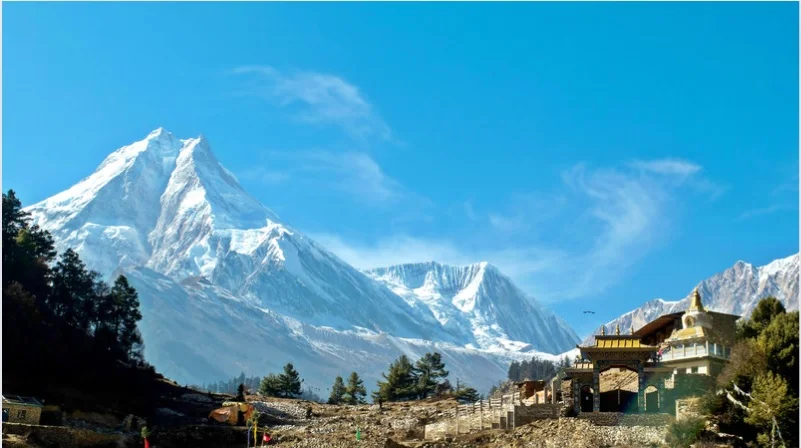Nestled high in the Himalayas, Manang is a remarkable town in the Manang District of Nepal. This high-altitude settlement, located at 28°40’0N 84°1’0E with an elevation of 3,519 meters (11,545 feet), is a vital part of the region’s geography, culture, and trekking routes. This article delves into the various aspects of Manang, providing an in-depth look at its location, demographics, geographical significance, and cultural importance.
Geographical Location and Significance
Manang is strategically situated in the broad valley of the Marshyangdi River, north of the majestic Annapurna mountain range. The river, flowing to the east, creates a unique landscape that is both rugged and serene. To the west of Manang lies the Thorong La pass, a significant high-altitude pass at 5,416 meters (17,769 feet). This pass leads to the sacred Muktinath shrine and the valley of the Gandaki River, connecting various important trails and pilgrimage routes.
The northern side of Manang is dominated by the Chulu East peak, standing tall at 6,584 meters (21,601 feet). This peak, along with the surrounding terrain, offers breathtaking views and challenging climbing opportunities for mountaineers and trekkers. It’s location on the northern slope of the valley ensures it receives the most sunlight and the least snow cover in winter, making it a relatively hospitable environment for its residents and visitors alike.
Demographics
According to the preliminary results of the 2011 Nepal census, its District has a population of 6,527 people living in 1,495 individual households. The population density is a sparse 3 persons per square kilometer, highlighting the remote and expansive nature of the region. The low population density is a testament to the challenging living conditions at high altitudes and the rugged terrain that characterizes Manang and its surroundings.
Historical and Cultural Context
It holds a significant place in the history and culture of the Annapurna region. The village has traditionally been an important stopover for traders, pilgrims, and trekkers. Historically, Manang was part of an ancient trade route connecting the fertile valleys of Nepal with the arid plains of Tibet. This historical significance is still evident today, as the town serves as a key acclimatization stop for trekkers undertaking the Annapurna Circuit, one of the most popular trekking routes in the world.
The culture of Manang is deeply influenced by Tibetan Buddhism, reflected in the local monasteries, chortens (Buddhist shrines), and prayer flags that dot the landscape. The residents of Manang, known as Manangis, have preserved their unique cultural heritage and traditions over the centuries. The local festivals, traditional attire, and rituals provide a fascinating glimpse into the life and customs of the high Himalayas.
Trekking and Tourism
This is a vital hub for trekkers on the Annapurna Circuit. Most trekking groups take resting days in Manang to acclimatize to the high elevation before attempting the Thorong La pass. The town offers various amenities to cater to the needs of trekkers, including guesthouses, restaurants, and shops selling trekking gear and supplies. Acclimatization days in Manang often involve short hikes to nearby viewpoints, visits to local monasteries, and exploring the surrounding landscape.
The terraced cultivation fields on the north slope of the valley add to the scenic beauty of Manang. These fields are a testament to the agricultural ingenuity of the Manangis, who have adapted to the harsh climatic conditions to grow crops such as barley, wheat, and potatoes. The sight of these terraced fields, set against the backdrop of towering snow-capped peaks, is truly mesmerizing.

Infrastructure and Development
In recent years, Manang has seen significant infrastructure development. The construction of motorable roads and trails has improved connectivity and accessibility to the region. Goods are now transported to Manang via jeeps, mule trains, and porters, ensuring a steady supply of essential items to the town. This development has also boosted the local economy, providing new opportunities for trade and tourism.
A small airport, located 2.5 kilometers (1.6 miles) east of the town, was once a crucial link for the region. Although the airport has not had commercial flights since 2012, it played a significant role in the past, especially during emergencies and for transporting goods and people to and from the valley. The airport, which began operations in 1985, is a reminder of the challenges and achievements in connecting remote Himalayan regions to the rest of the country.
The completion of a trail linking Manang to the Annapurna Conservation Area in February 2011 has brought numerous benefits to the villagers and the area. This trail has enhanced the trekking experience, providing safer and more scenic routes for trekkers while promoting environmental conservation. The trail’s development is part of broader efforts to balance tourism growth with sustainable practices, ensuring the preservation of it’s natural beauty and cultural heritage for future generations.
Challenges and Future Prospects
Despite the progress, Manang faces several challenges. The harsh climatic conditions, with cold winters and limited agricultural seasons, pose difficulties for the local population. The remoteness of the region also means limited access to healthcare, education, and other essential services. However, the resilient spirit of the Manangis, combined with ongoing development efforts, holds promise for the future.
Tourism remains a double-edged sword for Manang. While it brings economic benefits and improved infrastructure, it also raises concerns about environmental degradation and cultural erosion. Sustainable tourism practices, community involvement, and strict conservation measures are crucial to ensuring that it’s pristine environment and rich cultural heritage are preserved.
Conclusion: Manang
Manang, with its stunning landscapes, rich cultural heritage, and strategic location, is a jewel in the Himalayas. From its historical significance as a trade route to its current role as a trekking hub, itcontinues to captivate the hearts of those who visit. The town’s development, while bringing modern amenities and improved connectivity, must be balanced with sustainable practices to protect its unique environment and culture. As Manang navigates the challenges and opportunities of the future, it remains a testament to the resilience and spirit of the high Himalayas.









